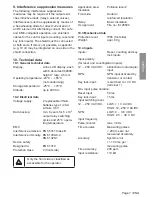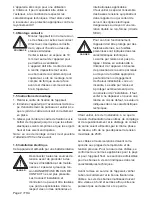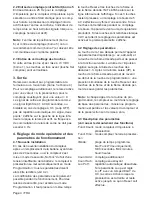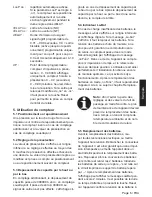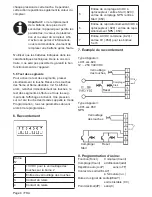
english
Page 3 | ENG
1.8 Start-up
• Is the device properly set and programmed
(function; max. counting frequency for coun-
ters)?
1.9 Failure possibilities and causes
Impossible to use the keys:
• Key lock input activated
Counter does not count:
• Wrong or reversed wiring of the counting input
• Setting of an input signal not matching the
pulse generator.
• No ground connection between the pulse
generator and the counter.
• Signal levels do not reach the switching
threshold of the counter.
Relay output signal missing:
• Output contact short-circuited
• Output signal (fugitive signal duration) pro-
grammed too short
• Relay contact defective due to excessive load
• Relay current below min. value
Displaying noFunc:
• Battery is unloaded and must be replaced.
If, despite all, your device still does not operate,
contact your local representative or call us
directly for technical support.
When sending your device back, please attach
a short description of the failure, of the program-
ming and of the connection diagram, in order to
allow us to reproduce a possibly existing defect
and to repair your device as quickly as possible.
2. Inputs
2.1 Reset input terminal 6
This input is connected functionally in parallel
with the red Set key and sets the counter to
zero in case of adding counting and to the pre-
set value in case of subtracting counting. The
reset function is dynamic.
The device has been designed for overvoltage
category II. If higher transient voltages cannot
be excluded, additional protection measures
must be taken in order to limit the overvoltage to
the values of CAT II.
Advice on noise immunity
All connections are protected against external
sources of interference. The installation location
should be chosen so that inductive or capacitive
interference does not affect the device or its
connecting lines! Interference (e.g. from switch-
mode power supplies, motors, clocked control-
lers or contactors) can be reduced by means of
appropriate cable routing and wiring.
Measures
• Use only shielded cable for signal and control
lines. Connect cable shield at both ends. Mini-
mum cable conductor cross-section 0.14 mm
2
.
• The shield connection to the equipotential
bonding should be as short as possible and
with a contact area as large as possible (low-
impedance).
• Only connect the shields to the control panel, if
the latter is also earthed.
• Install the device as far away as possible from
noise-conducting cables.
• Avoid routing signal or control cables parallel
to power lines.
1.7 Cleaning and maintenance
The front side of the unit should only be cleaned
using a soft damp (water!) cloth. Cleaning of
the embedded rear side is not planned and is
the responsibility of the service personnel or of
the installer.
In normal operation, this device is maintenance-
free. Should the device nevertheless not ope-
rate properly, it must be sent back to the manuf-
acturer or to the supplier. Opening and repairing
the device by the user is not allowed and can
adversely affect the original protection level.

















